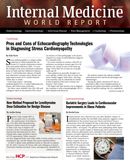Publication
Article
Internal Medicine World Report
Childhood Obesity and Risk of Allergy or Asthma
Author(s):
A recent study looked at the relationship between obesity and a child's risk of developing allergies or an asthmatic condition. Looking at what the authors perceived to be a growing trend of not only an increase in the number obese children but those suffering from new or worsening allergies the authors said they were looking for a link which could help treat the pediatric patients.

As childhood obesity becomes a growing issue, so do other potential conditions associated with it.
A recent study looked at the relationship between obesity and a child’s risk of developing allergies or an asthmatic condition. Looking at what the authors perceived to be a growing trend of not only an increase in the number obese children but those suffering from new or worsening allergies the authors said they were looking for a link which could help treat the pediatric patients.
Ultimately, they said finding that link had not yet been achieved.
“Despite data suggesting the epidemiologic link between asthma and obesity, the relationship remains unclear and many confounders (gender, ethnicity, genetic factors, and comorbidities) are likely to influence the obesity-asthma link.
Part of the data for the study came from the National Health and Nutrition Examination Survey (NHANES) from 2009 through 2010, which noted that 16.9% of children in the United States were obese — only slightly lower than 18.6% of adolescent boys and slightly more than 15% of adolescent girls. “Since 1980, the prevalence of obesity in children and adolescents has tripled,” the authors said.
They also point out that asthma in those children up to age 17-years-old increased from 3.6% in 1980 to 9.5% from 2008 through 2010. The most common groups to see the sharp increase, according to the authors, were those in “low socioeconomic strata and minority populations.”
The relationship between obesity and asthma, they noted, could be a cause and effect relationship as well.
“The hypothesis of asthma preceding obesity is supported by the evidence that asthmatics receive frequent steroid bursts, are likely to exercise less fearing asthmatic symptoms, stay more indoors leading to increased exposure to indoor air pollution, and pursue a sedentary lifestyle.”
Looking at a previous study the authors also noted that in that instance psychological factors played a role in the rate of childhood obesity.
“With many prospective studies from different countries, it has been observed that obesity is likely to precede asthma in most scenarios,” they said. “However, there remains a likelihood of a subgroup of children (especially the early onset phenotype in which asthma might precede obesity.”
The authors also noted inconsistencies in the studies for the diagnosis of both asthma and obesity itself.
“The evidence evaluating the obesity-asthma link in children has to be viewed carefully, because there are plaguing issues pertaining to the definitions of asthma and obesity,” they said. “Most of the studies have defined asthma using self- or parent-reported symptoms or physician diagnosed asthma. Few studies have used stringent asthma diagnosis, including bronchodilation or bronchoprovocation tests.”
While the link between obesity and asthma has been established in prior studies, the authors noted that finding a similar link between obesity and allergies has been harder to determine. They also cited other studies that showed a link between the gender of children and their likelihood of allergies.
In Australia, a survey of Caucasian children “suggested that higher BMI (body mass index) was associated with a higher prevalence in girls only,” they said. There were similar results reported in a survey conducted in New Zealand.
“As evident from these studies, there is no consistent evidence of association between obesity and atopy,” they said. “The obesity-asthma relationship is also stronger in non-atopic asthma compared with atopic asthma, with possible effect modification by gender. The association of obesity with markers of allergic inflammation, like peripheral eosinophil counts and exhaled nitric oxide is also not consistent.”
The authors noted that, the association between BMI and allergic disorders other than asthma is conflicting and is possibly modified by age, gender, ethnicity, and type of disease.” They added, “The association between BMI and eczema is fairly consistent. However, there is no/inverse relationship between BMI and allergic rhinitis/rhinoconjunctivitis.
Furthering the link between obesity and asthma the authors also noted that there have been studies that show losing weight can help reduce the symptoms of asthma.
“A systematic review evaluating weight loss and asthma demonstrated a consistent improvement in at least one asthma-related outcome in all 15 eligible studies,” they noted. “Standard asthma management protocols now mention weight loss as a part of therapy in obese/overweight individuals.”






